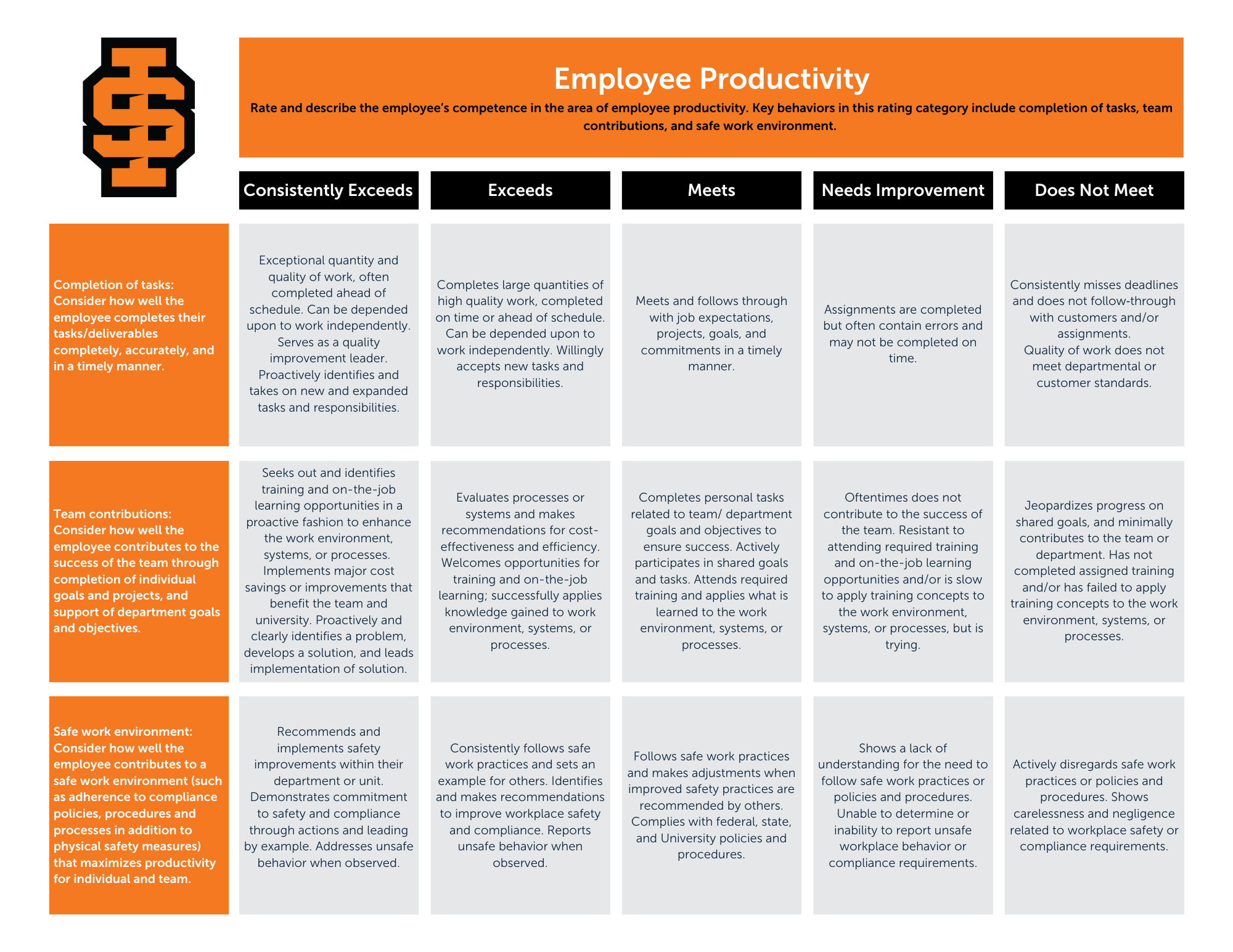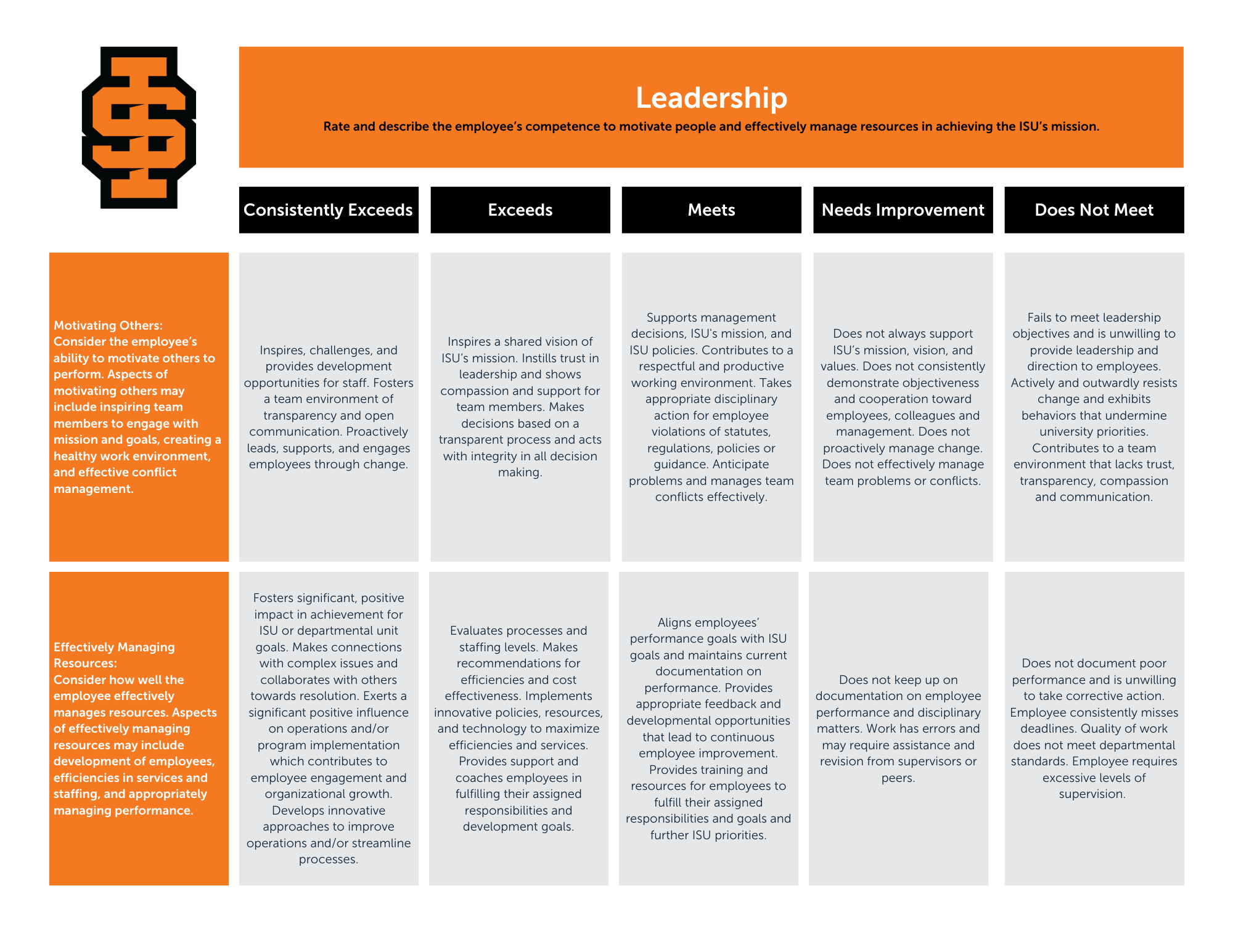Performance Evaluation Guidance
Performance evaluations are part of a collaborative, ongoing feedback process between the supervisor and employee. You can find answers to frequently asked questions below.
Performance Evaluation Matrices
Performance Evaluation Matrices were created to provide an in-depth evaluation tool to assist supervisors in assigning appropriate ratings for employee performance. They can be viewed below or via the Performance Evaluation Matrices document.




Evaluations serve to formalize and document how an employee performed their job in comparison with the expectations of their job. By doing so, performance is reinforced or noted as needing change or improvement. This formal assessment supports compensation decisions or personnel actions such as reclassification, salary adjustments, and corrective actions. While the evaluation is a once-a-year event, managers are expected to provide performance feedback to employees on a regular basis throughout the year. Content in an evaluation should not be a surprise to an employee.
Completing a self-evaluation is advantageous for both the employee and the manager. It serves as a formal tool for the employee to give input to their manager about accomplishments and challenges that occurred during the year as well as providing an opportunity for them to bring up desired work-related development or goals. It allows the employee’s “voice” to be part of their employment history. For the manager, receiving a self-evaluation can often serve to remind of events worth noting in the annual evaluation. Additionally, it indicates how the employee feels about their own performance for the year which can help the manager construct an effective evaluation discussion.
The following are the important dates for the staff performance evaluations:
- Self-review period opens 11/19/2025
- Self-review due by Friday, 12/12/2025
- Supervisor evaluation due by Friday, 1/16/2026
- 2nd level review due by Friday, 2/13/2026
- Supervisor sign off due by Thursday, 2/26/2026
- Employee acknowledgement due by Friday, 2/27/2026
- Reflect the full 12 months and the whole picture of performance.
- Be specific with feedback on performance and include the business impact.
- Sync content with feedback you have provided throughout the year; there should be no surprises.
- Don’t document poor performance or conduct if you have not specifically discussed it with the employee during the course of the review year and allowed reasonable time for improvement.
- Use clear language.
- Give examples.
- Do not refer to medical leaves, ADA accommodations, grievances, Title IX investigations, or compliance complaints.
ISU uses a five-level rating scale for performance evaluations. View the for a more in-depth breakdown rating scales.
The Idaho State Legislature is responsible for the distribution of public funds, in coordination with the Division of Financial Management (DFM) and Division of Human Resources (DHR). Each year, the legislature votes to:
- Determine whether State of Idaho employees will receive pay raises, and
- Define some structure as to how those raises will be implemented.
The State of Idaho refers to these compensation adjustments as the Change in Employee Compensation, or CEC.
If legislation is approved, details are shared with each state agency, including Idaho State University. From there, ISU leadership works together to prepare a distribution plan based on these legislative requirements and submit our plan to DHR and DFM for approval.
The State of Idaho’s compensation philosophy is one of paying for performance. Meaning stronger performance generally equals a higher percentage of merit increase. By direction of the State of Idaho and Idaho Code, performance and compa-ratio (for classified staff) must be factors in our CEC matrix and distribution plan.
- Conduct regular conversations throughout the year with direct reports to provide all types of feedback on performance and behaviors in relation to expectations.
- Review last year’s annual evaluation and notes from 1:1s and feedback discussions. Review responsibilities and goals for the past year. Review self-evaluation.
- Seek feedback from others (customers, colleagues, direct reports).
- Consider development options and goals for the new review year.
- Complete an annual evaluation on each eligible employee, assessing their performance and providing examples to support your assessment. Provide a copy to the employee to read over prior to the evaluation discussion to maximize the meeting time for discussion.
- Consult with HR if you plan to assess an overall rating below “Meets” for any staff member.
- If an overall assessment is lower than the highest rating available, be prepared to address the question from your employee of, “What do I do to be rated exceeds next year?”
- Request feedback from your manager as needed and as practical throughout the year. Realize that your manager may not be prepared to give feedback at the moment you ask.
- “Last week was the first time I did X. I’d appreciate hearing what you think worked well and didn’t work so well.”
- “We’re about half way through the year and I want to check in and see how I’m doing. Is there anything you want me to do less of or more of?”
- If asked to complete a self-evaluation, think about your accomplishments both in the context of work performed and the competencies you demonstrate when working. Provide brief examples to emphasize your points.
- Consider what development would enhance your success in the job.
Managers and employees often have questions about the evaluation process or want to talk through how best to have a discussion. There are several resources for these types of questions depending on need:
Staff who were hired on or after October 1, 2025 will not complete an annual evaluation. However, they will receive a probationary evaluation from their supervisor prior to the end of their probationary period.
Existing ISU employees who transfer to a new job or a new manager receive an annual evaluation. This may be challenging when the employee is learning a new job or the employee and manager are new to each other. Depending on the specifics of the situation, consider the following options:
- The job responsibilities contained in the annual evaluation will be associated with the employee’s current job. However, current managers may consider seeking narrative input from the former manager regarding overall performance of the employee and then input that information in the overall evaluation section of the annual evaluation.
- Self-evaluations are particularly helpful in these situations as employees are able to offer a description of their past job and performance.
- Managers are encouraged to be transparent in conveying the newness of the employee when writing the content of the evaluation. If it is too soon to make an assessment higher than “Meets”, state that. Do take an opportunity to assess how the employee is learning the new role.
The responsibility for completing an annual evaluation goes to the manager’s manager. In some cases, that manager’s manager may delegate to another manager if that person has greater insight into the employee’s performance. Whomever is writing the evaluation should review past evaluations. A best practice for managers who are leaving their role is to provide an interim evaluation for staff that can be part of the formal annual evaluation.
This is the most important part of the evaluation process. Both parties should determine the most important messages they want to convey and be prepared to give and receive feedback.
Discussion includes reviewing accomplishments, areas for development, and goals and changes for the upcoming year. As mentioned, it is advised that managers provide the written evaluation to their employees prior to the discussion so the employee has time to digest the content.
Managers facilitate the discussion and there are many ways to conduct an evaluation discussion. Some ideas:
- Provide a verbal outline for the discussion at the onset of the meeting.
- Example:“We have an hour scheduled and to make sure we cover everything, let’s start by discussing the past year and some evaluation specifics. That would lead us into talking about development and goals for the new review year. And then I’d like to have some time for you to tell me what support you need from me and ideas you might have for the group. How does that sound?”
- If the employee has submitted a self-evaluation, a manager could begin the discussion with an overall observation of how in sync or how different the content is between self-evaluation and annual evaluation.
- Example: “It looks like we are thinking similarly about the work you’ve performed this year. Let me highlight some of the areas that I see as key accomplishments.”
- Example: “I think we may have some differences in the way we are assessing the customer service aspect of your position. But as far as X and Y and Z, I think we’re in sync. I agree with what you said about……. And let’s talk more about customer service……”
- After confirming that the employee has read the annual evaluation, consider asking some questions before digging in on specifics. Explore how the employee is feeling about the evaluation. Such as,
- “Is there anything in the evaluation that is a surprise to you?”
- “Is there anything that I didn’t note in the evaluation that you wished I had?”
- “How are you feeling about the overall assessment of your performance?”
If an employee is in this situation, they should express their concern and provide information to their manager that may influence the desired change. Employees are welcome to contact the HR Office to discuss their concern and seek options on actions they could take.
The employee can acknowledge the evaluation with or without comments once the evaluation has been completed, this acknowledgement may express their concerns and/or disagreement of the content found in the evaluation. If the manager completes the final acknowledgement and then determines that updates are required on the evaluation, they can work with the HR Office to return the review to the manager or the employee.
Employees are asked to sign as an acknowledgement of receipt. A signature does not mean agreement. If an employee does not want to sign their evaluation, they are not required to do so. Employees are encouraged to contact the HR Office or an Ombuds to discuss options if they have ongoing concerns regarding their evaluation.
Managers are expected to provide useful feedback on a regular basis to employees regarding performance in comparison to expectation and follow through on commitments made to the employee during the evaluation discussion. Some managers schedule a mid-year informal evaluation discussion, no documentation required. When giving feedback, use specific and recent examples as much as possible.
- Sustaining feedback: Reinforces that performance is meeting or exceeding expectations and encourages more of the same.
- Development feedback: Acknowledges performance fully meets expectations and encourages a stretch to the next level.
- Corrective feedback: Explains a gap between performance and expectation and recommunicates expectation. The quicker that corrective feedback is given, the quicker an employee can make the desired change.
Employees are encouraged to ask for feedback if they are uncertain of how their performance is perceived by their manager or if they need to better understand an expectation. Employees are also encouraged to give feedback to their managers on how their manager can better support them.
Example: When you told us about process change X at the staff meeting and told us that was our chance to give feedback before it was implemented, I felt like I needed more time to process my thoughts. When the next process change comes up, is there a way that you can give us the information and then let us think about it for a day or two before we give feedback?
